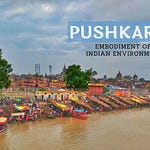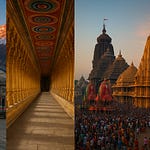📍 Location: Koliyak Beach, Bhavnagar District, Gujarat
🛕 Deity: Lord Shiva (Mahadev)
🔱 Significance: One of India’s most mystical Shiva temples, revealed only during low tide
🧭 Origin & Mythological Background
The Nishkalank Mahadev Temple traces its spiritual foundation to the Mahabharata era. After the great war of Kurukshetra, the Pandavas were overwhelmed with guilt and spiritual unrest for the bloodshed they had caused — even though they fought for righteousness (dharma). To absolve themselves of sin, they sought the guidance of Lord Krishna.
Lord Krishna advised the Pandavas to carry a black flag and a cow and travel until both turned white. Upon reaching a sacred and sinless land, they must establish a shrine for Lord Shiva.
The journey led them to the shores of Koliyak, near present-day Bhavnagar. As foretold, the black flag and cow turned white here. Recognizing the land as Nishkalank (spotless/sinless), the Pandavas established five Shiva Lingas, symbolizing purity, forgiveness, and transcendence.
🕉️ Historical Legacy & Foundation
Though rooted in mythology, the temple structure has existed for centuries, revered through oral traditions and sacred accounts.
The original linga sites are preserved in their natural form, standing on rocky pedestals deep in the Arabian Sea.
Local records and priests' lineage trace the caretaking of the temple across multiple generations.
🌊 The Mystery of the Submerged Temple
What makes Nishkalank Mahadev truly mystical and awe-inspiring is that:
The temple is submerged underwater during high tide and only emerges during low tide.
It is located nearly 1 km inside the sea, on a muddy, submerged path.
This daily miracle of nature — the appearance and disappearance of the temple — adds to its sanctity and aura.
Five distinct Shiva Lingas, each with a flagpole and Nandi statue, appear from the waters like sacred sentinels of the sea.
🔱 Religious Significance
The word "Nishkalank" translates to "stainless" or "pure", indicating a space free of karmic burden.
It is one of the very few temples in the world where Shiva is worshipped within the ocean.
It represents the spiritual cleansing of sins and ego, much like the Ganga in Varanasi or the Rameswaram Jyotirlinga.
Pilgrims believe that praying here washes away sins, grants peace of mind, and clears the path to moksha (liberation).
🛕 Temple Structure and Layout
Five Shiva Lingas representing the five Pandavas
Nandi statues in front of each linga
Raised platforms to keep the deities safe from the waves
A flagpole beside each linga, which devotees re-hoist during auspicious times
A simple black stone slab, now used as an altar for offerings
There are no walls or domes, and the open-air setting amidst the sea connects directly with cosmic elements — water, air, earth, fire (sun), and ether.
🪔 Rituals, Puja, and Aarti
Puja Timings: During low tide hours (typically early morning till before noon)
Main Rituals:
Abhishekam with seawater, milk, curd, honey, ghee
Offerings of Bilva leaves, coconut, and red flowers
Lighting of lamps and chanting of Shiva mantras
Aarti: Usually performed by local priests when the temple is accessible. It includes:
Shiva Aarti with conch blowing and bell ringing
Devotees join in the chanting of “Om Namah Shivaya”
Deep daan (offering of lighted lamps) into the sea after prayers
📅 Festivals Celebrated
1. Maha Shivaratri – Grandest celebration with thousands of devotees visiting
2. Shravan Month (July-August) – Special Mondays see huge pilgrim footfalls
3. Amavasya Days – Believed to be highly auspicious for cleansing rituals
4. Full Moon (Purnima) – Observed with collective chanting and sea offerings
5. Local Coastal Fairs – Held annually with devotional performances, prasad, and boat processions
🧘 Pilgrimage & Tirth Importance
This temple is revered as a tirtha-sthal (sacred pilgrimage site) for Shiva bhakts, second only to Somnath and Nageshwar Jyotirlinga in Gujarat.
It is believed that taking darshan of all five lingas together is equivalent to visiting five jyotirlingas.
Pilgrims often combine this with Gopnath Mahadev or Blackbuck National Park visits.
🧭 Travel Guide
✈️ Nearest Airport:
Bhavnagar Airport (~20 km away)
Ahmedabad Airport (~200 km, well-connected)
🚉 Nearest Railway Station:
Bhavnagar Terminus (connected to major cities)
🚗 By Road:
Located 30 km from Bhavnagar City
Well-connected by buses, taxis, and private vehicles
🏨 Where to Stay:
Lodges and dharmshalas in Bhavnagar city
Seaside cottages and hotels available
📌 Best Time to Visit:
October to March (pleasant weather, easier tides)
Avoid monsoon due to rough sea and tide unpredictability
🛑 Important Tips for Pilgrims
Check tide schedules from local authorities or temple trust
Wear comfortable, washable clothes and avoid footwear during sea walk
Carry water, towel, and small bag for offerings
Walk carefully on slippery and muddy terrain
Children and elderly must be assisted
Travel in groups for safety
The Nishkalank Mahadev Sea Temple is not just a temple — it is a living symbol of nature’s rhythm and divine mystery. It bridges the mythical with the physical, the cosmic with the earthly, offering an unmatched experience of devotion, awe, and inner purity.
To witness Shiva rising from the sea — timeless, calm, forgiving — is to truly understand the essence of “Nishkalank”.










